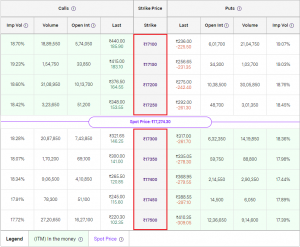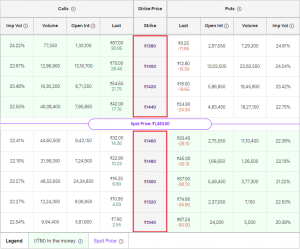Chapter 1
Strike Prices: You’ve got ‘options,’ babe!
Multiple strike prices are one of the features that make options a unique asset class. This is what enables you to use options for speculation, hedging and as an extra income stream. But before we get there, first let’s understand the concept of strike prices.
What is a strike price?
Disclaimer: It is not the price you pay for buying an option. Then what is it?
Let’s say the Nifty50’s current price is 17,274. You, a buyer, expect the index to rise from here. You want to benefit from the up-move by trading in index options. The market offers a wide choice of prices at which you can buy index options. That means you can strike a deal in the Nifty at 17,274 or any price above or below it. Pretty unique isn’t it? In equity or in futures, you don’t get such a choice.
Your choices will probably look like the following table. Look at the column in the centre, highlighted in red.
Illustration 1: Nifty50 strike prices

Source: https://upstox.com/option-chain/nifty/
So, according to the chart in our example, you can buy Nifty at 17,700 (its current price) or at 17,500 or even at 17,900, or at any other available price. (Do note, for the sake of understanding strike prices, we will only discuss buying call options here).
Good to know
Each of these predetermined prices provided by the stock exchange is called the strike price. It is the price at which the buyer agrees to buy and the seller agrees to sell. The strike price is also called the exercise price.
Why are so many strike prices provided?
Options have multiple uses. You can use options for speculation or for hedging. You could also be using options in combination with a stock in your portfolio, to earn extra income. You can choose from various strike prices based on your view on the underlying stock or index. This would depend on factors like:
- The direction of movement (up, down, sideways)
- Size of the movement
- The expiry date of the contract
- The entry price of the portfolio stock to be hedged
But, as we already saw, the strike price is not the price you pay to buy an option. Then why is it so significant? Take a look.
The strike price-option value link
The value of an option equals the difference between the strike price and the underlying stock or index. This difference is what helps you gauge whether an option is ‘in-the-money’, ‘at-the-money’, or ‘out-of-the-money.’ This difference is called the ‘intrinsic value’ of the option. Thus, keeping other things constant, the value of a call option with a strike price of 17,500 should be at least ₹200 if the current price is 17,700.
This ₹200 is called the intrinsic value of the option.
Current price - Strike price = Intrinsic value of call option
Example 1:
17700 - 17500 = 200
Example 2:
17700 - 17900 = 0
Since value cannot be less than 0.
Example 3:
17700 - 17700 = 0
Do note here that intrinsic value also is not the option price or option premium. Option price also includes a time value component. We will discuss intrinsic value and option prices in an upcoming chapter.
For now, let’s go back to illustration 1. You will notice that the difference between two strike prices is constant. These are called intervals. So, who decides the strike price or the intervals?
Are all strike prices available at the same intervals?
If you notice in illustration 1 above, Nifty strike prices are available at an interval of 50 points viz. 17,650, 17,700, 17,750 and so on. Similarly, if you look at the strike prices for HDFC Bank below, they are available at an interval of 20 points.
Illustration 2: HDFC Bank

Source: https://upstox.com/option-chain/hdfc-bank-ltd/
The stock exchange determines the strike prices as well as the strike intervals from time to time. The basic rule is higher the price level, the higher the interval.
While we will learn more about the moneyness of options in the upcoming chapter, here is some information about strike prices and strike intervals. In case of the Nifty 50 index, the exchange provides 30 ‘in-the-money’, 1 ‘at-the-money’, and 30 ‘out-of-the-money’ (30-1-30) strike prices with a strike interval of 50 points.
Similarly, for Bank Nifty, the exchange provides 40 ‘in-the-money’, 1 ‘at-the-money’, and 40 ‘out-of-the-money’ (40-1-40) strike prices at an interval of 100 points. Further, for individual stock options, the strike scheme is based on the volatility of the underlying stock.
To decide the at-the-money strike price, the underlying closing value is rounded off to the nearest strike price interval. The in-the-money strike price and the out-of-the-money strike price are based on this at-the-money strike price interval.
Good to know
When you trade options and you move from one strike price to the next, the price of the options changes and so does the probability of profit.
Great, so we have multiple strike prices to choose from, and these keep increasing as per market movements. Feel as confused as a child making a choice in an ice-cream shop? We get you! You can use the following filter - liquidity - to help narrow down your choice.
Liquidity
Usually, the strikes that are closer to the current price are the most liquid (i.e. have more buyers and sellers) while those far from the current price are less liquid. Let’s look at the available liquidity at three different strike prices when Nifty was at 17,700. As you can see in illustration 3 below, the closer the strike to the current price, the higher the liquidity.
Illustration 3: Higher liquidity at strikes near the current price

Source: NSE
Further, strikes at round numbers usually have higher activity and are relatively more liquid than the ones in between. In illustration 4, we display how the round strikes of 17500 and 17600 have more liquidity than the uneven strike of 17550. Higher liquidity makes it easy and quick to buy and sell contracts at the best possible prices.
Illustration 4: Higher liquidity at round numbers

Source: NSE
To Conclude:
- Strike price is the price at which the buyer and seller agree to buy or sell an option.
- Strike price is not what you would pay to buy an option. It helps determine the price or premium of the option.
- The stock exchange determines the strike prices and strike intervals. It provides multiple strike prices which are presented in the form of an option chain.
- Strike prices closer to the current price are more liquid.
- Strike price is essential to determine the break-even point.
Hope that clears up strike prices for you. In the next chapter, we will tackle a closely linked topic - Moneyness.

Test your OQ (Options Quotient)
Take your first step towards financial independence with the right training.



